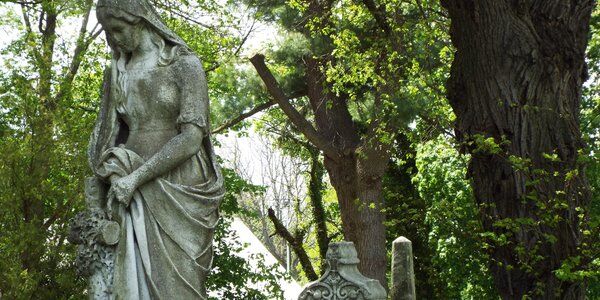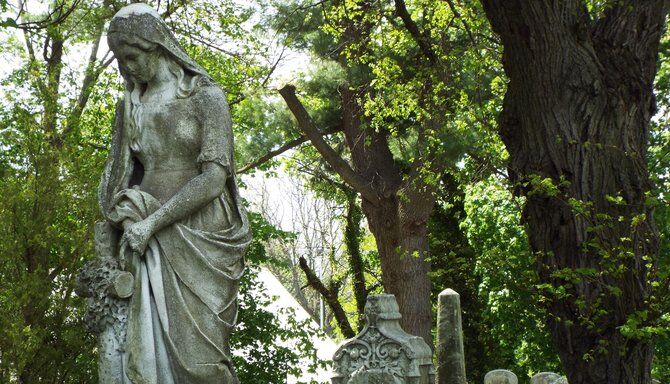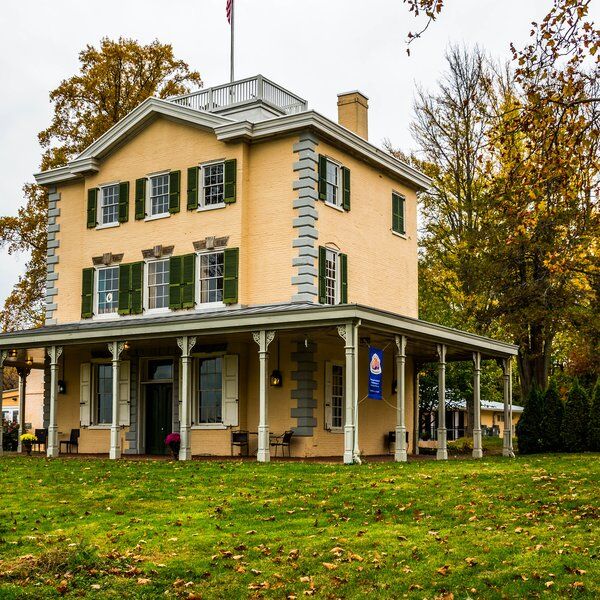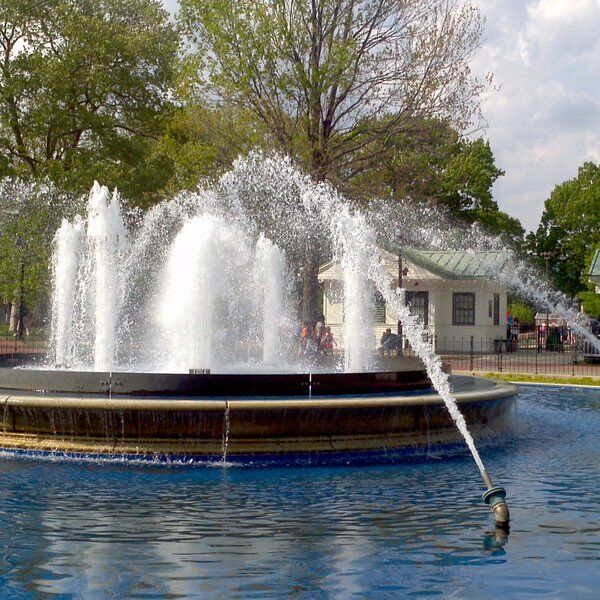Discover Laurel Hill Cemetery
Philadelphia is brimming with history, and among its many iconic landmarks is the fascinating Laurel Hill Cemetery. Often referred to as Laurel Hill East, this historic site in the East Falls neighborhood isn't your typical graveyard. Spanning 74 picturesque acres along the Schuylkill River, it was one of the first rural cemeteries in the United States, following the model set by Mount Auburn Cemetery in Boston. Today, it’s a designated National Historic Landmark, a recognition that highlights its significance not just as a burial ground but as a hotspot for cultural exploration.

The History of Laurel Hill Cemetery
An Original Idea
By the early 19th century, urban burial grounds in America were becoming overcrowded and unsanitary. Cities like Philadelphia were rapidly expanding, and traditional churchyards were often dug up to make way for roads and buildings.
This grim reality inspired John Jay Smith, a librarian, editor, and grieving father, to reimagine burial practices. After witnessing the distressing conditions of his daughter’s burial, Smith resolved to create a tranquil and dignified resting place, free from the noise and chaos of city life.
Selecting the Perfect Spot
Smith, along with several prominent Philadelphians, formed the Laurel Hill Cemetery Company in 1836. They chose a serene 32-acre estate called “Laurel” on the east bank of the Schuylkill River. This estate, once owned by businessman Joseph Sims, provided a picturesque, rural setting far removed from the city center. Though the city would later grow around it, Laurel Hill retained its peaceful character.
Designing a Landmark
To bring his vision to life, Smith enlisted the talents of Scottish-American architect John Notman, known for his ability to harmonize architecture with natural landscapes. Notman designed the cemetery in a “Gardenesque” style, incorporating terraces, winding paths, and panoramic river views. His designs drew inspiration from the English garden cemeteries of the time, such as Kensal Green Cemetery in London. The result was a place where art, nature, and memorialization came together beautifully.

A Cultural and Social Hub
In its early years, Laurel Hill was more than just a burial ground; it was a destination. Before public parks and museums became widespread, cemeteries like Laurel Hill offered a rare opportunity for recreation and cultural engagement.
Visitors flocked to the cemetery to stroll among its manicured gardens, admire the grand monuments, and enjoy the stunning views of the Schuylkill River. By the 1840s, it was so popular that admission tickets were required!
Growth and Expansion
As the cemetery's popularity grew, so did its footprint. Between 1836 and 1861, additional parcels of land were acquired, eventually expanding the site to its current size of 95 acres. This growth included notable sections like South Laurel Hill and Central Laurel Hill, which added even more stunning landscapes and historical significance.
When the expansion of Fairmount Park in the 1860s limited further growth on the east side, the company established Laurel Hill West across the river in Bala Cynwyd. While the eastern cemetery retained its ornate and monument-dense style, Laurel Hill West embraced a more open and naturalistic design influenced by the “Landscape Lawn” movement.
Monuments and Memorials
Laurel Hill quickly became a showcase of artistic talent. Wealthy families commissioned elaborate tombs and sculptures, employing famous artists like Alexander Milne Calder and Harriet Whitney Frishmuth. The monuments reflected styles ranging from Classical Revival to Gothic Revival and even Egyptian Revival, using materials such as marble, granite, and cast iron.
One particularly unique feature is the set of sandstone statues by Scottish sculptor James Thom, depicting scenes from Sir Walter Scott’s Old Mortality. Placed at the cemetery’s entrance, these statues symbolize the enduring care and memory that Laurel Hill promises to uphold.

Preserving the Cemetery
In the modern era, Laurel Hill has continued to adapt and thrive. The Friends of Laurel Hill Cemetery, a nonprofit organization, was founded to ensure the site’s preservation and promote its cultural and educational value. Through their efforts, the cemetery has remained a vibrant part of Philadelphia's landscape, offering historical tours, horticultural events, and more.
Becoming a National Historic Landmark
Laurel Hill earned its place on the National Register of Historic Places in 1977 and later became the first cemetery in the country to receive National Historic Landmark status in 1998. This distinction underscores its importance not only as a burial ground but as a landmark of American history, architecture, and culture.

The Arboretum at Laurel Hill Cemetery
Laurel Hill is a certified Level II Arboretum, which means you’re basically stepping into a tree encyclopedia when you visit. Spanning a whopping 265 acres, this arboretum contains over 6,500 trees and shrubs representing 950 unique species, it’s a feast for your eyes and lungs. Some of these trees even hold "state champion" status, making them botanical royalty. Stroll through vibrant display gardens, marvel at flowering shrubs, or simply bask in the shade of towering canopy trees—all for free!
The cemetery doesn’t just honor its past—it embraces the future with eco-friendly horticultural practices. It’s the perfect blend of 19th-century garden vibes (thanks to founder John Jay Smith) and modern sustainability.
Quirky Highlights
Laurel Hill isn’t short on intriguing structures either. Some standouts include:
- Stone Entrance (circa 1894): The grand entryway that welcomes you into this serene retreat.
- Octagonal Dead House (circa 1894): A winter storage solution for caskets that once doubled as a grave-digging innovation lab. Caretaker George Norton used to heat the ground with a fire and iron hoops to make digging possible in freezing temperatures.
- Ladies' Waiting Room (circa 1901): This charming Italianate-style building had a dual purpose—a tool shed and, yes, a restroom for the ladies.
- Bolton Cenotaph (1921): A striking WWI memorial created by Emmanuel Hahn to honor soldiers buried elsewhere.
Add to that a 90-foot wooden bridge that once connected the hills, iron hoops in walls for tying horses, and an ornate trestle bridge, and you’ve got a site that practically begs for exploration.

Famous Burials at Laurel Hill Cemetery
Laurel Hill isn’t just a place for peace and reflection; it’s also a historical who’s who of famous figures, and you never know who you might come across during a stroll through the cemetery. After its creation, this cemetery quickly became the go-to burial ground for Philadelphia’s elite, from business magnates to military heroes.
Civil War Graves
One of the most famous names associated with Laurel Hill is General George Gordon Meade, the Union commander who played a pivotal role in the Battle of Gettysburg. You can visit his grave and imagine the weight of history that lies there, or just take in the peaceful atmosphere of the surrounding cemetery grounds.
Laurel Hill was also a resting place for other Civil War-era generals, including 42 who fought valiantly in the conflict. If you’re a history enthusiast, this is a great spot to pay respects to some of the nation's military greats.
Industrial Graves
But it’s not just Civil War-era figures that rest here. The cemetery also serves as the final resting place for prominent industrialists like Matthias W. Baldwin, founder of the Baldwin Locomotive Works, Peter A. B. Widener, a financier and philanthropist, and Henry Disston, the saw-making magnate who ran the largest saw factory in the world. These men helped shape Philadelphia’s rise to industrial prominence.
Sport Heroes
More modern figures have also found their way to Laurel Hill. If you’re a sports fan, don’t miss the grave of Harry Kalas, the beloved Phillies sportscaster. His grave is marked with a giant microphone and bright blue stadium chairs, a fitting tribute to his role in the team’s history.
Art in Stone
And for art lovers, don’t miss Aspiration, a breathtaking sculpture by Harriet Whitney Frishmuth, or the lavish Berwind tomb monument, a showstopper among tombstones. These monuments show that Laurel Hill isn’t just about the past—it’s a place where modern culture and history meet in a beautiful, serene setting.

Laurel Hill Cemetery in Popular Culture
Laurel Hill Cemetery isn’t just a serene resting place—it’s a pop culture hotspot! Movie buffs might recognize its iconic gates and lush grounds from Rocky Balboa (2006) and Creed (2015), where the tombstones for Adrian Balboa and Paulie Pennino feature prominently. Rocky’s emotional graveside visits? They were filmed right here in the South Laurel Hill section.
Action aficionados, don’t fret—this cemetery has room for robots and justice-seekers too! It was a filming location for Transformers: Revenge of the Fallen (2009) and Law Abiding Citizen (2009).
And if you're a fan of YA fiction, you might already know that Tombstone Tea by Joanne Dahme brought its pages to life with this very cemetery as the backdrop, complete with cameos from historical figures buried here.

Visiting Laurel Hill Cemetery
- Hours: 7:00 am – 7:00 pm (Spring/Fall), 7:00 am – 5:00 pm (Winter).
- Admission: Free, except for guided tours.
- Parking: On-site and street options available.
Events and Programs
Laurel Hill Cemetery is far from your average burial ground—it’s a vibrant hub of activity. With over 100 public programs annually, there's always something happening, from lantern-lit evening tours to collaborations with local nonprofits.
Guided Tours and Self-Exploration
There are walking tours every fourth Friday, at the cemetery, which let you explore the stories etched into its stones, while the annual Gravediggers Ball is a must for lovers of eerie elegance. And if you want a more tailored experience, private tours are available, led by certified guides.
Want to wander solo? Grab a $5 guidebook from the office or download their “I Spy Tombstone Hunt” brochure—a family-friendly activity that turns headstone symbols and Civil War graves into an interactive adventure. You can even enhance your visit with an audio tour, accessible right from your phone.
Prefer a more casual vibe? Pack a picnic, leash your pup, and enjoy the peaceful beauty of the grounds. Just don’t climb the monuments—some are over a century old and prone to toppling (not exactly the thrill you want).

Beyond Laurel Hill Cemetery in Philadelphia with CityDays
While the Laurel Hill Cemetery is a must-visit, Philadelphia has so much more to offer.
With CityDays, you can embark on exciting scavenger and treasure hunt tours that take you through the city’s historic neighborhoods and to other beloved landmarks.
These interactive tours are perfect for team-building exercises, offering a fun and engaging way to learn more about Philadelphia’s history and culture.
And CityDays’ tours are not just limited to Philadelphia—they’re available in cities around the world, making them a great option for corporate events, family outings, and group adventures.
















